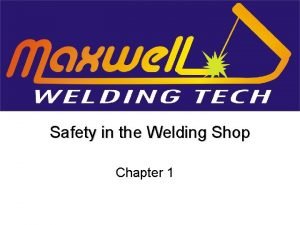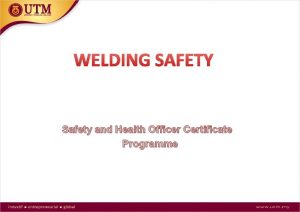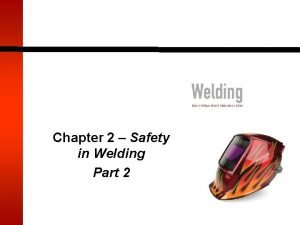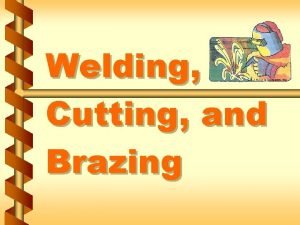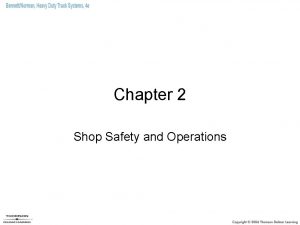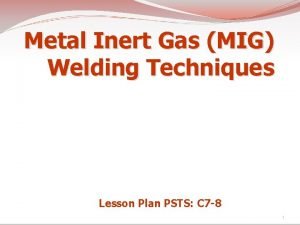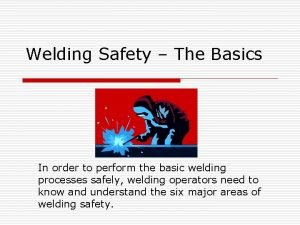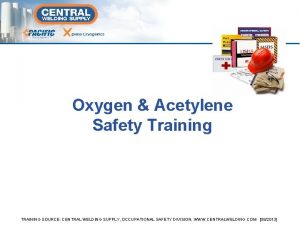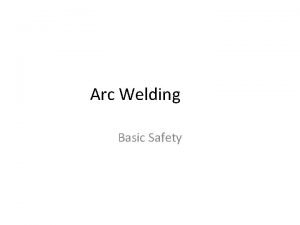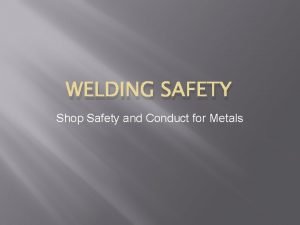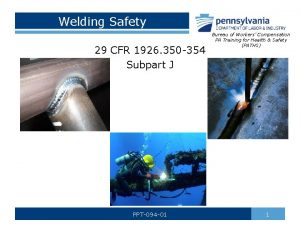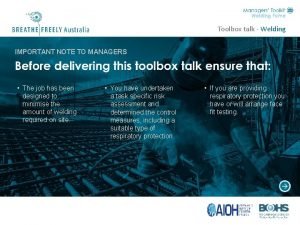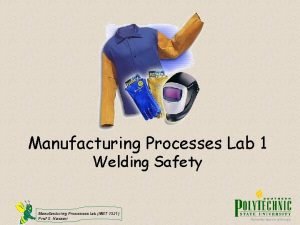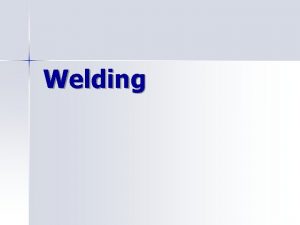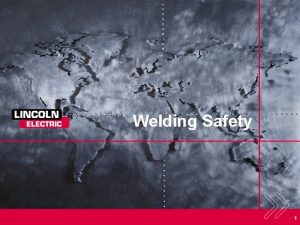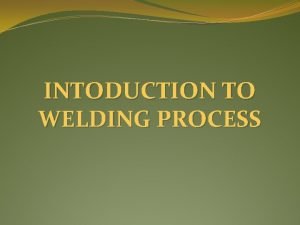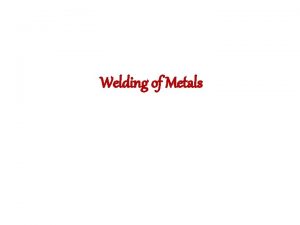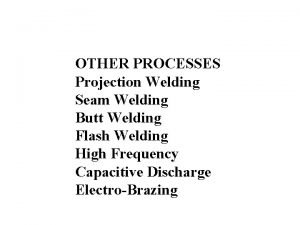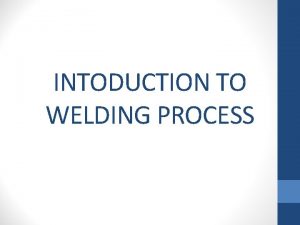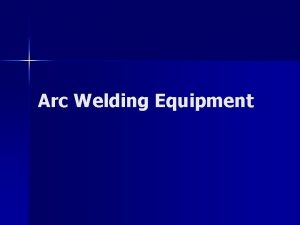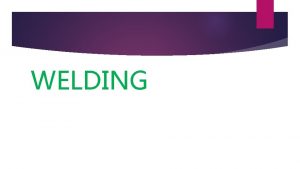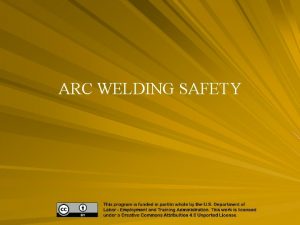Chapter 2 Safety in Welding Part 2 Welding














- Slides: 14

Chapter 2 – Safety in Welding Part 2

Welding seems smoky, does smoke present a problem? • The first defense against fumes and gases is for the welder to keep away from the plume. • Plume – Is a column of heat that rises from the welding arc containing particulate matter and vapors caused by the breakdown of filler metal, welding gas and base metal constituents. Welding By David J. Hoffman, Kevin R. Dahle, David J. Fisher 2 © 2012 Pearson Higher Education, Upper Saddle River, NJ 07458. • All Rights Reserved.

• Gases and fumes from welding, cutting and heating must be properly vented. • Toxic gases produced by the welding arc are: – Carbon monoxide – Nitrogen dioxide – Ozone Welding By David J. Hoffman, Kevin R. Dahle, David J. Fisher 3 © 2012 Pearson Higher Education, Upper Saddle River, NJ 07458. • All Rights Reserved.

Ventilation • What guidelines exist to determine proper ventilation? 1. In a space that is less than 10, 000 cubic ft. per welder 2. In a room having a ceiling height less than 16 ft. 3. Confined spaces • When is ventilation not enough protection? When welding applications include fluorine compounds, zinc, lead, beryllium, cadmium, mercury, cleaning compounds, and cutting stainless steels, special precautions apply. • Any concerns for welding in confined spaces? Welding in confined spaces must be done in a manner that prevents the accumulation of toxic materials or possible a oxygen deficiency. Welding By David J. Hoffman, Kevin R. Dahle, David J. Fisher 4 © 2012 Pearson Higher Education, Upper Saddle River, NJ 07458. • All Rights Reserved.

• This booth, specifically designed for arc welding, has a moveable exhaust ventilation at the table and overhead exhaust ventilation. Welding By David J. Hoffman, Kevin R. Dahle, David J. Fisher 5 © 2012 Pearson Higher Education, Upper Saddle River, NJ 07458. • All Rights Reserved.

• Moveable exhaust ventilation at the table Welding By David J. Hoffman, Kevin R. Dahle, David J. Fisher 6 © 2012 Pearson Higher Education, Upper Saddle River, NJ 07458. • All Rights Reserved.

What considerations are made for possible fire hazards? • Properly maintained fire extinguishers must be available. • Post a fire watcher to the work area. ØFire watch will be provided during work, for at least 30 minutes after work, and during breaks in work. Welding By David J. Hoffman, Kevin R. Dahle, David J. Fisher 7 © 2012 Pearson Higher Education, Upper Saddle River, NJ 07458. • All Rights Reserved.

Hot Work Permit • A hot work permit is a document that provides step-by-step procedures for workers to follow in areas where welding and cutting are not normally performed and is issued by the fire safety supervisor or other responsible party Welding By David J. Hoffman, Kevin R. Dahle, David J. Fisher 8 © 2012 Pearson Higher Education, Upper Saddle River, NJ 07458. • All Rights Reserved.

Explosion • What special precautions must be taken when welding on containers or enclosures? Ø Tanks, barrels, or other containers that have held fuels, oils, tars, or any other flammable materials might become flammable or explosive, or toxic vapors may form that can be harmful to the welder/cutter. Ø These containers must be systematically cleaned to remove harmful elements completely before welding or cutting can begin Ø Purging with an inert gas such as argon, nitrogen, or helium is recommended in all cases to eliminate the possibility of combustion Welding By David J. Hoffman, Kevin R. Dahle, David J. Fisher 9 © 2012 Pearson Higher Education, Upper Saddle River, NJ 07458. • All Rights Reserved.

How should compressed gas cylinders be stored? Ø Inside of buildings, compressed cylinders shall be stored in a well-protected, well-ventilated, dry location at least 20 feet from highly combustible materials. • How might a cylinder be damaged? Ø Tipping the cylinder over or dropping it Ø Close contact with flames, sparks, and electrical cables • How are cylinders moved? Ø Cylinders should be moved with the valve cap securely in place Welding By David J. Hoffman, Kevin R. Dahle, David J. Fisher 10 © 2012 Pearson Higher Education, Upper Saddle River, NJ 07458. • All Rights Reserved.

Are there special concerns regarding fuel gases? Ø Acetylene tanks that have been lying on their side must be upright for at least 15 minutes prior to use. How is a compressed gas cylinder set up? Ø High-pressure compressed gas cylinders must be handled with care. Ø Cylinder caps must be secured firmly when in transport. Warning! Should a cylinder fall without the cap in place, the valve stem might break, and the high pressure gas will propel the tank like a missile. Welding By David J. Hoffman, Kevin R. Dahle, David J. Fisher 11 © 2012 Pearson Higher Education, Upper Saddle River, NJ 07458. • All Rights Reserved.

Is it okay to spray oxygen on your clothing? • No • Oxygen will not burn but it vigorously supports and accelerates combustion, causing materials to burn with great intensity. Oil or grease in the presence of oxygen may ignite and burn violently. Welding By David J. Hoffman, Kevin R. Dahle, David J. Fisher 12 © 2012 Pearson Higher Education, Upper Saddle River, NJ 07458. • All Rights Reserved.

• Always stand on the opposite side of the valve when opening it. Welding By David J. Hoffman, Kevin R. Dahle, David J. Fisher 13 © 2012 Pearson Higher Education, Upper Saddle River, NJ 07458. • All Rights Reserved.

• Working pressure on a shielding gas regulator. • Make sure to back off the pressure adjusting screw before pressurizing the regulator Welding By David J. Hoffman, Kevin R. Dahle, David J. Fisher 14 © 2012 Pearson Higher Education, Upper Saddle River, NJ 07458. • All Rights Reserved.
 Welding shop safety assessment
Welding shop safety assessment Smaw safety
Smaw safety Chapter 2 welding safety quiz
Chapter 2 welding safety quiz Welding chapter 2
Welding chapter 2 Welding fire safety
Welding fire safety Chapter 2 shop safety
Chapter 2 shop safety Joint design in welding
Joint design in welding Mig welding patterns
Mig welding patterns Welding safety precautions
Welding safety precautions Welding safety precautions
Welding safety precautions Welding porosity
Welding porosity Welding shop safety
Welding shop safety Osha 1926 welding
Osha 1926 welding Welding safety toolbox talk
Welding safety toolbox talk Welding safety
Welding safety
